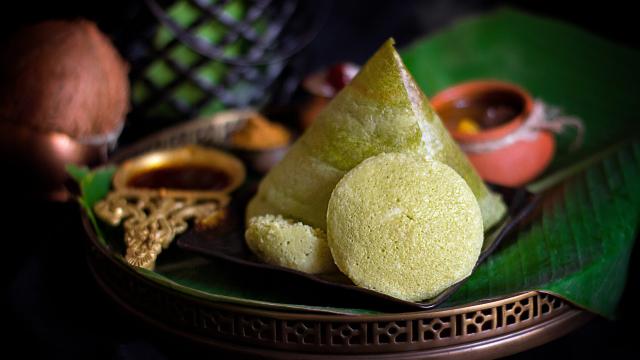We Indians love our fermented food, from the crumbly steamed dhokla and fluffy white idlis, to the fried wadas and the flavourful kadhi. One of the staples, preferred in the southern part of the country but relished all over, is the humble dosa. This protein-rich crepe is made from a fermented batter of urad dal (split black gram) and rice.
Be Basic
If you’ve never made dosa before, it’s quite simple. Here’s an easy dosa batter recipe, courtesy of retired banker Sreekala Warrier.
Using a rice to dal ratio of five portions of rice to one of dal by volume, cover your rice and dal with water and soak them separately overnight. (Urad dal rises, so you’ll need to add extra water if you choose to use it.)
The next morning, grind the two separately. Warrier uses a wet grinder, but a food processor can also be used; just make sure you grind everything until it’s very smooth.
Start off by adding very little water — you can use the water in which the rice and dal was soaked — then add a little more when the mixture gets cakey, but only enough to aid the grinding process. If you add too much water at the beginning, the mixture won’t grind well and the batter will turn grainy.
Dal grinds easily and releases water, so it will require less water than the rice. If you’re using a food processor, the grinding process takes less than 20 minutes.
Combine the ground rice and dal mixtures, and grind them together until they are absolutely smooth.
Cover the batter and leave it out overnight to rise. Some people add a pinch of methi (fenugreek seeds, roasted and powdered) to the batter. Warrier adds it just before making the dosa, along with salt to taste.
Before making the dosa, get it to the right consistency by adding enough water until it it thickly coats a spoon dipped in it. On a clean, hot tava (griddle) or nonstick pan over medium heat, add a spoon of the batter and spread it to form a circular pancake; ghee can be added for a quicker fry.
Once the corners start lifting up and the top of the batter looks cooked, flip it with a spatula. (If, however, you are working with a very thin batter, you may not need to flip it.)
The finished dosa will look golden brown, and is best eaten hot, served with a coconut chutney and sambhar.
Handy Tips
Making a dosa may appear simple but there’s much that can go wrong. If you’re trying it for the first time, we have some handy tips.
- If the batter won’t rise, add a little yoghurt and let the mixture sit for half an hour.
- Before pouring the batter, clean the pan with a moist towelette or tissue. This will prevent your dosa from sticking and tearing.
The Veggie Touch
In Anjali Aruldas’s Mumbai home, the dosa prepared is rarely plain. The 58-year-old is the founder of Vanakkam Foods, which offers ready-to-cook eats and batters for dosa, idli and vadai. Aruldas has experimented with vegetable batters using vegetables such as beetroot, carrots and palak (spinach).
“These are an easy and healthy way of getting children and the elderly to eat more vegetables,” she says. “In addition, the vegetables add a vibrant colour to the dosa.”
The process begins with cleaning, washing and then boiling the vegetables — salt and a few spices can be added for flavouring. Leafy vegetables such as spinach can be blanched, but harder ones such as carrots and beetroot need to be pressure cooked until soft (they can also be boiled or roasted until cooked completely).
Once soft, the vegetables are pureed until they gain a smoothie-like consistency. “Don’t strain the puree because then you will lose the fibre and nutrients,” advises Aruldas. You can also blitz the vegetables raw but this will give a grainy texture to the batter, and it will spoil faster.
The amount of water used in the puree depends on the consistency of the dosa batter — if it is thin, then drain the water after boiling or blanching. Aruldas advises keeping the vegetable batter and dosa batter separate, and mixing it only just before cooking. Both batters should be used within three days.
In terms of ratios, it’s kind of up to you. “I use about 20 per cent of the vegetable mixture folded into the batter. If you want more veggie flavour, you can increase the amount,” she says.
The Grain Story
Beyond vegetables, it is possible to add grains such as ragi (millets), makhana (foxtail nuts), jowar (sorghum) and bajra (pearl millet).
Each grain is different, in flavour and texture. The first step, says Aruldas, is to figure out your consistency. “A 1:2 ratio of grains to dosa mixture is ideal; if you like the grains and want that flavour to shine, increase the ratio,” she says.
Wash and then soak the grains the night before or for eight to 10 hours; they’re hard so they take longer to soften.
In a wet grinder, mix in the soaked grain and water — this helps you decide the thickness. “It’s a trial and error process. Don’t be disheartened if you don’t get it right the first time. Use the water you soaked the grains in so there’s no loss of nutrients,” she says.
Another option is to grind the grains into a fine powder, and then create a batter by adding in a little water. The cooking process is the same. The advantage of adding grains is that the dosa crisps up on its own, without the need for ghee or butter.

Comments